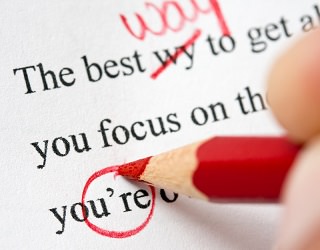Proofreading Practice:
Can You Find All 10 Errors?
Proofreading Practice
Get proofreading practice finding the mistakes in this cause and effect essay. It has been revised but still needs to be checked for punctuation and grammar errors. (You can use the proofreading checklist as a guide.)

See if you can find and correct all 10 mistakes. Look at capitalization, punctuation, and spellings. Then check for subject-verb agreement. Look for sentence fragments and run-on sentences. (Print this page or write the corrections on a piece of paper.)
When you finish proofreading, find & mark (or write down)
- the thesis statement,
- at least three sentences that give details or examples supporting the thesis,
- and the conclusion.
- Underline or copy transition words.
Finally, write a short, one-paragraph summary of the most important points of the essay.
Unintended Consequences:
Hitler and the Bomb
Hitler knew he wanted to “free” Germany from its Jews, including its Jewish scientists. However, he probably never imagined the far-reaching implications of that decision. It led to the United States getting the atomic bomb, and eventually to the nuclear arms race.
One of the first laws Hitler's government passed when it came to power in Germany in 1933 forbade people with any Jewish grandparents from working for the civil service (government), including the universities. His party was proud of German science, and wanted to keep it “pure” from the strange thinking introduced by Einstein and others.
This law led to many brilliant scientists losing their university jobs. Many also realized that as Jews they were unwelcome and possibly at risk in Germany. Some left immediately for university positions in Great Britain or the U.S. others followed as they realized their danger. And as Germany invaded much of Europe.
Many of them had been working to understand the atom. They realized its terrible power if used for destruction—and knew that German scientists were also working on atomic fission. The thought that the Germans might develope an atomic bomb moved several of them, including Albert Einstein, to send a letter to the American president. They proposed the U.S. government should start urgent research to make a usable bomb before the Germans could.
After some time, the government agreed. It started a massive secret program they called the Manhattan Project. Thousands of American and British scientists worked on it. They were led by Robert Oppenheimer, an American of Jewish background who had studied physics in Germany in the 1920s. Nearly 30 top Jewish scientists who had fled German-controlled (or Fascist) Europe ended up there too, as well as many jewish-American scientists who also hated the ideology Hitler introduced and would do anything they could to opose it.
The bomb they developed was ready for final testing in July 1945. It far more destructive than they had even imagined. By this time the Nazis had been defeated, but the war with Japan continued. The American government decided to use their new weapon against Japan.
Many of the scientists who had worked on the Manhattan Project. had hoped the bomb would never be used. As the Cold War began, they strongly urged an end to atomic weapons.
However, the American government felt they needed the threat of atomic warfare to keep the Soviet Union (US.S.R.) from further aggression. Before long (partly due to secrets a very few of the Manhattan scientists had shared with the U.S.S.R. during the war, when it was still in theory an “ally”), it had developed an atomic bomb of its own.
This led quickly to a nuclear “arms race.” Within a few years Great Britain, France, China, and several other nations. Had also made and tested such bombs. once scientists understood the principles. it proved impossible to keep the technology from spreading.
No one could have predicted all the consequences that followed from Hitler's hatred of the Jews or from the persecution of Jewish scientists.
Those scientists started out developing the atomic bomb in a race against time, since they knew Hitler’s scientists were working on the same project. They won that race, but ended up using the bomb anyway—and transforming the nature of war and the future of humanity.
Check Your Proofreading Practice
Here are the Proofreading practice answers. (The page also identifies the thesis statement, supporting details, and transitions. It gives a suggested summary, plus a bibliography of the online sources for the essay.)
How did you do? If this was difficult, see Learn to Write English, Proofreading Checklist, or Transition Words.
Home> Learn to Write English > Proofreading Practice.
P.S. I used a number of online sources for research while writing this essay. Several are no longer available. The complete list (of those still available online) is at the bottom of the Proofreading Practice Answers page above.
Didn't find what you
needed? Explain what you want in the search box below.
(For example, cognates, past tense practice, or 'get along with.') Click to see the related pages on EnglishHints.
| site search by freefind | advanced |





